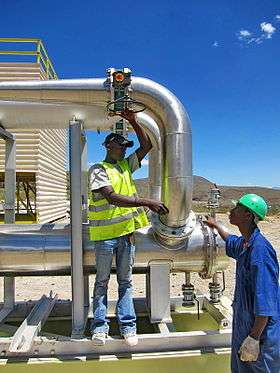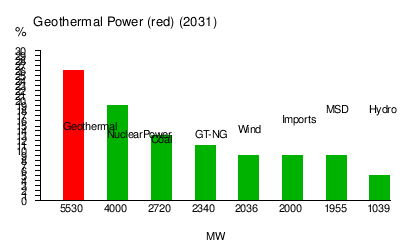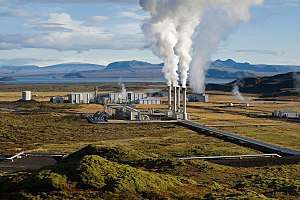Geothermal power in Kenya

Geothermal power is very cost-effective in the Great Rift Valley of Kenya, East Africa. Kenya was the first African country to build geothermal energy sources. The Kenya Electricity Generating Company, which is 74% state-owned, has built three plants to exploit the Olkaria geothermal resource, Olkaria I (195 MW), Olkaria II (105 MW) and Olkaria IV (150 MW, 75 MW Wellhead generation plants, with a third private plant Olkaria III (139 MW). Additionally, a pilot wellhead plant of 2.5 MW has been commissioned at Eburru and two small scale plants have been built by the Oserian Development Company to power their rose farm facilities with a total of 4 MW. Kenya currently has 636 MW of installed geothermal capacity.
2030

|
By 2030 Kenya aims to have 5,530 MW of geothermal power or 26% of total capacity.[1] This will make it Kenya's largest source of electricity clean energy by 2030.
Geothermal power plants have a prominent place in Kenya’s overarching development plans. These include the Vision 2030, the NCCAP, and the current ‘5000+ MW in 40 months initiative’. Geothermal power has the potential to provide reliable, cost-competitive, baseload power with a small carbon footprint, and reduces vulnerability to climate by diversifying power supply away from hydropower, which currently provides the majority of Kenya’s electricity. Kenya has set out ambitious targets for geothermal energy. It aims to expand its geothermal power production capacity to 5,000 MW by 2030, with a medium-term target of installing 1,887 MW by 2017. Although there is significant political will and ambition, reaching these ambitious goals is a major challenge.[2]
The Kenyan Government’s plan to increase geothermal energy production to over 5,000 MW by 2030 is part of Kenya Vision 2030, which highlights the country’s ambition to become a middle-income country by 2030.[3]
A study funded by the Climate and Development Knowledge Network found that the Kenyan and Ethiopian approach to geothermal development puts little focus on involving the private sector in risk mitigation and fails to build the capacity needed for flows of significant private sector finance. The study found that international, multilateral and bilateral institutions should:
- Support technical assistance and capacity building, which takes into account the needs of all relevant stakeholders involved within specific country and market contexts.
- Provide targeted concessional finance by taking into account all possible risk mitigation instruments during project development, and by envisioning the leverage of private finance as early as possible.
- Use insurance instruments to target specific, well defined risks: this can offer very high leverage ratios on the use of public funds, and crowd in private sector insurance capital.[4]
See also
References
- 1 2 "Archived copy" (PDF). Archived from the original (PDF) on 2013-06-13. Retrieved 2013-08-04.
- ↑ "INSIDE STORY: Nationally Appropriate Mitigation Action (NAMA) to accelerate geothermal power: Lessons from Kenya - Climate and Development Knowledge Network".
- ↑ Government of Kenya (2007) Kenya Vision 2030: The popular version. Nairobi: Government of the Republic of Kenya (http://www.vision2030.go.ke)
- ↑ "WORKING PAPER: Innovative risk finance solutions - Insights for geothermal power development in Kenya and Ethiopia - Climate and Development Knowledge Network". Climate and Development Knowledge Network. Retrieved 2017-03-10.
